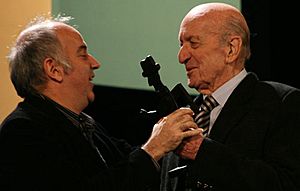Eduardo Falú facts for kids
Quick facts for kids
Eduardo Falú
|
|
|---|---|

Eduardo Falú (right)
|
|
| Background information | |
| Born | July 7, 1923 El Galpón, Salta, Argentina |
| Died | August 9, 2013 (aged 90) Buenos Aires, Argentina |
| Genres |
|
| Occupation(s) | |
| Instruments | Guitar |
| Years active | 1945–2009 |
Eduardo Falú (born July 7, 1923 – died August 9, 2013) was a famous Argentine folk music guitarist and composer. He was known for creating beautiful melodies and songs inspired by the traditions of his home country.
Contents
Who Was Eduardo Falú?
Eduardo Falú was born in 1923 in a small village called El Galpón, near San José de Metán in the Salta province of Argentina. His parents, Fada and Juan Falú, had moved there from Syria. Growing up in the countryside, he was greatly influenced by the rich folk traditions of Salta. He often said that these traditions were "something lively, dynamic and evolutionary."
Learning Music and Becoming Famous
Eduardo received his first guitar as a gift when he was a child. He quickly started playing traditional folk tunes from the Argentine Northwest. He became a troubadour, which is like a traveling musician who sings and plays.
In the 1940s, he formed a musical group with César Perdiguero. They became very well known in their region. Even though Eduardo mostly taught himself to play the guitar, he also studied the works of famous 19th-century guitar masters. He learned about harmony and music theory from a well-known Argentine composer named Carlos Guastavino.
Moving to Buenos Aires and First Recordings
As Eduardo became more famous, he moved to Buenos Aires, the capital city of Argentina, in 1945. He recorded his first music album there in 1950.
He worked with many leading Argentine poets, writing music for their words. Some of his most popular songs came from his collaborations with Jaime Dávalos. These include Zamba de la Candelaria, Trago de sombra, and Canción del jangadero. Eduardo also wrote music for important Argentine historical stories, like Romance de la Muerte de Juan Lavalle (with words by Ernesto Sábato) and a piece about José Hernández (with words by Jorge Luis Borges).
Performing Around the World
Eduardo Falú performed outside Argentina for the first time in Paris, France, in 1959. After that, he played in many other major cities like Rome, Los Angeles, and Madrid.
He was especially popular in Japan. From 1963 to 1973, he performed there over 200 times! In later years, he often performed with his nephew, Juan Falú, who is also a talented musician.
His Musical Legacy
Many people consider Eduardo Falú to be the person who started Argentina's modern folk song movement. He created music for more than 150 poems. These included poems by Borges and Dávalos, as well as by León Benarós, Manuel J. Castilla, and Alberico Mansilla.
He was famous for his Chamamé, Chacarera, and Zamba compositions. These are all traditional Argentine music styles. Later in his career, Falú also composed two longer musical pieces called suites: Primera Suite Argentina (in 1996) and Segunda Suite Argentina (in 1999).
Awards and Recognition
Eduardo Falú received many honors for his amazing work. The Government of Perú gave him a Distinguished Service Award. In 1985, his fellow Argentine musicians honored him with the Konex Award, which is one of the highest cultural awards in Argentina. He also received a Grand Prize from the Argentine Society of Music Composers (SADAIC).
His last album, released in 2009, was a special tribute to the famous classical Spanish guitarist Andrés Segovia. Eduardo Falú passed away on August 9, 2013, at his home in Buenos Aires, Argentina. He was 90 years old.
See also
 In Spanish: Eduardo Falú para niños
In Spanish: Eduardo Falú para niños

